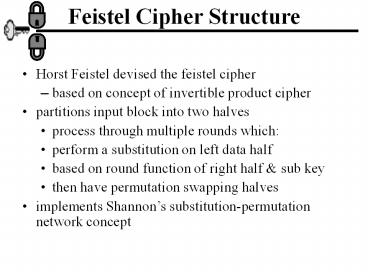Feistel Cipher Structure - PowerPoint PPT Presentation
Title:
Feistel Cipher Structure
Description:
Feistel Cipher Structure. Horst Feistel devised the feistel cipher. based on concept of invertible product cipher. partitions input block into two halves – PowerPoint PPT presentation
Number of Views:2957
Avg rating:3.0/5.0
Title: Feistel Cipher Structure
1
Feistel Cipher Structure
- Horst Feistel devised the feistel cipher
- based on concept of invertible product cipher
- partitions input block into two halves
- process through multiple rounds which
- perform a substitution on left data half
- based on round function of right half sub key
- then have permutation swapping halves
- implements Shannons substitution-permutation
network concept
2
Feistel Cipher Structure (1973)
- Virtually all conventional block encryption
algorithms including data encryption standard
(DES) are based on Feistel Cipher Structure. - The plaintext is divided into two halves
- Then the two halves pass through n rounds of
- processing then combine to produce the cipher
- block.
- Each round has as input and
derived from the previous round as well as a
sub-key derived from the overall
3
Feistel Cipher Structure (1973)
- All rounds have the same structure
- A substitution is performed on the left half of
the data. This is done by applying a round
function to the right half of the data
followed by the XOR of the output of that
function and the left half of the data.
4
Classical Feistel Network
5
Classical Feistel Network
6
Design Features of Feistel Network
- Block Size (larger block means greater security)
64 bits. - Key Size56-128 bits.
- Number of Rounds a single round offers
inadequate security, a typical size is 16 rounds. - Sub-key Generation Algorithms greater complexity
should lead to a greater difficulty of
cryptanalysis. - Round function Again, greater complexity
generally means greater resistance to
cryptanalysis.
7
Design Features of Feistel Network
- .
- Round function Again, greater complexity
generally means greater resistance to
cryptanalysis. - Fast Software encryption/Decryption the speed of
execution of the algorithm is important. - Ease of Analysis to be able to develop a higher
level of assurance as to its strength - Decryption use the same algorithm with reversed
keys.
8
Feistel Encryption and Decryption
9
Simplified DES (S-DES)
- Developed by Prof. Edward Schaefer of Santa Clara
University 1996. - Takes 8 bit block of plain text and 10 bit key as
input and produce an 8 bit block cipher text
output. - The encryption algorithm involves 5 functions
initial permutation (IP) a complex function fk
which involves substitution and permutation
depends on the key simple permutation function
(switch) SW the function fk again and final
inverse of the initial permutation( IP-1).
10
Simplified DES Scheme
11
Overview
- We can express the encryption algorithm as a
composition function - IP-1?fk2 ?SW ?fk1 ?IP
- OR
- CiphertextIP-1(fk2(SW(fk1(IP(plaintext)))))
- Where,
- K1P8(shift(P10(key)))
- K2 P8 (shift(shift(P10(key))))
- The decryption algorithm is
- PlaintextIP-1 (fk1(SW(fk2(IP(Ciphertext)))))
12
Key Generation for S-DES
13
Key Generation for S-DES
- First permute the key in the following way
- Ex (1010000010)is permuted to (1000001100)
- Perform a circular left shift to each bits of the
key - Ex (10000?01100)?(00001?11000)
- Next apply P8
- This yields K1(10100100)
P10 P10 P10 P10 P10 P10 P10 P10 P10 P10
3 5 2 7 4 10 1 9 8 6
P8 P8 P8 P8 P8 P8 P8 P8
6 3 7 4 8 5 10 9
14
Continue
- Then perform again 2 bit circular shift left on
each of the five bits - (00001)(11000)?(00100)(00011)
- Finally apply again P8
- Then K2(01000011)
15
S-DES Encryption
16
S-DES Encryption
- The i/p 8-bit block plaintext is first permuted
using the IP function - At the end of the algorithm the inverse
permutation is used - IP-1(IP(X))X
- Ex IP(10110101)(01111100)
- IP-1 01111100(10110101)
IP IP IP IP IP IP IP IP
2 6 3 1 4 8 5 7
IP-1 IP-1 IP-1 IP-1 IP-1 IP-1 IP-1 IP-1
4 1 3 5 7 2 8 6
17
The Function fk
- Let L and R be the left most 4 bits and rightmost
4 bits of the 8 bits input - fk (L, R)(L?F(R,SK),R)
- Where SK is a sub key and the ? is bit-by-bit XOR
function. - Ex if the o/p of the IP is (10111101) and
- F(1101,SK)(1110) for some SK then
- fk(10111101)(1011) ?(1110)(0101)
18
Continue
- Recall the first operation is an expansion and
permutation to first 4 bits as follows - We can depict the result as
- The 8 bit key K1is added to this value using XOR
E / P E / P E / P E / P E / P E / P E / P E / P
4 1 2 3 2 3 4 1
n4 n1 n2 n3
n2 n3 n4 n1
n4K11 n1 K12 n2 K13 n3 K14
n2 K15 n3 K16 n4 K17 n1 K18
19
Continue
- Let us rename these bits
- The first row of the matrix 4 bits are fed into
the S-box S0 to produce 2 bit o/p and the
remaining 2 bits are fed to S1 to produce another
2 bits
P0,0 P0,1 P0,2 P0,3
P1,0 P1,1 P1,2 P1,3
20
S-Box
- The s-box operates as follows (P0,0,P0,3 )
determine the row of the S0 matrix and (P0,1,P0,2
)determine the column - Ex if (P0,0,P0,3 ) (00), (P0,1,P0,2 )(10) then
the o/p is from row 0 and column 2 in S0 which is
equal to 3, i.e., (11) in binary. - In a similar way we can produce the other two
bits
21
The Switch Function (SW)
- SW interchange the left and right 4 bits so that
the second instance of fK operates on a different
4 bits.































